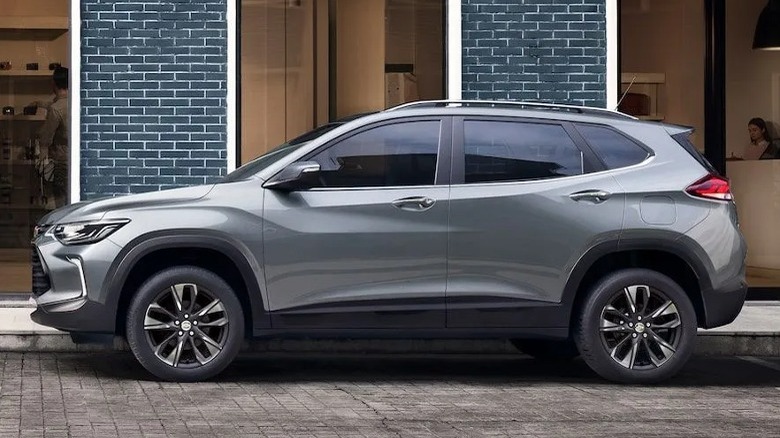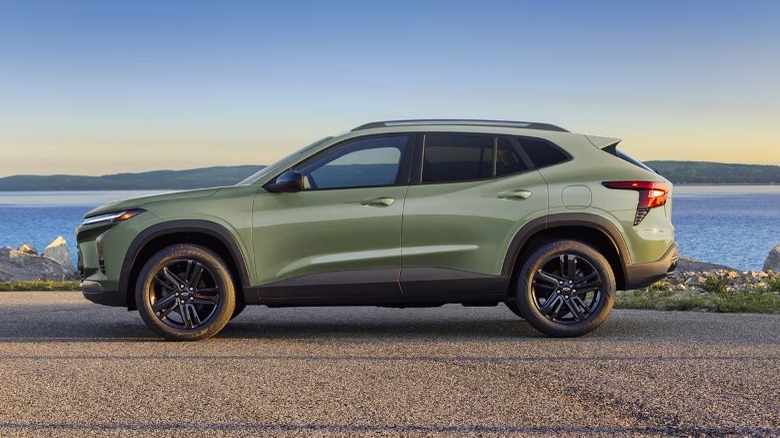What Year Did They Stop Making The Chevy Tracker & Is It The Same SUV As The Trax?
The world of automotive names is often like the music industry — band names are swapped around as members come and go (Jefferson Airplane becomes Jefferson Starship, for example), and tribute bands borrow bits of existing names to create their own. So it goes with the Chevrolet Tracker and Trax. But is it the same vehicle, give or take an option?
The original Tracker came to the U.S. from Suzuki in 1990 and was sold under the GM brand Geo. Available as a 2-door soft top or 4-door hardtop, its inline 4, 1.6L engine offered only 80hp, but the choice of RWD or 4WD was a pleasant surprise. The 2-door was only 142.5 inches long by 64.2 inches wide (without mirrors). Elsewhere, this vehicle was called the Suzuki Sidekick, a slightly higher-powered replacement for Suzuki's popular Samurai.
After 1997, the Tracker exchanged the Geo logo for Chevrolet branding, when the Geo brand was discontinued. By 1998, the Chevrolet Tracker's power plant grew to 95 hp and 98 lb-ft of torque from its 1.6-liter inline four and added an inch in length to the 2-door version. The 1999 model had a 120-horsepower 2.0-liter option, followed a couple of years later by an optional 2.5-liter V-6, a new engine with 155 horsepower and 160 lb-ft of torque for the 4-door model. The redesigned Tracker 2-door grew to 66.7 inches in width and 148.8 inches in length, giving rear-seat passengers a little more leg room.
Then, in 2004, the Tracker ceased production and the name went on hiatus.
Featured image by IFCAR via Wikimedia Commons | Cropped and scaled | Public domain
The Track(er) is back
The Tracker name was brought back in 2013 when Chevy introduced a small SUV for the South American market. The name was used in Russia as well. This Tracker was completely different from the original, based instead on the Opel Mokka. The same platform (the GM Gamma II) carried the Chevrolet Trax that was sold in Europe, China, and Canada. At the time, the Trax was not available in the US because the related Buick Encore held that market. The 2013 Tracker was only available with a 1.8L that produced 140 HP, with either 6-speed automatic or 5-speed manual. But buyers did have a choice of AWD or FWD.
Through the years, this small Tracker SUV remained affordable while still sporting amenities to lure a younger, less-affluent crowd. Depending on the trim, it offered an 8" color touchscreen, rain-sensing automatic windshield wipers, StabiliTrak stability control system, blind spot alert, front collision alerts and assists, and wireless smartphone charging, among other niceties. Sadly, the 2023 model dropped in horsepower to a turbocharged 1.2L engine with 130 horses, with either 5-speed manual or 6-speed automatic. It also began to be sold in China, with a distinctive nose and the option of a 1.5L engine with a CVT.
With the model year 2025, the Tracker is marketed in the Cayman Islands and South American countries such as Brazil for the entry-level segment. Engine choices are now the 1.0L 3-cylinder EcoTec Turbo making 116 hp, or a 1.2L, depending on the market.
The Chevrolet Trax -- a close cousin
In 2013, the small crossover Chevrolet Trax was also released on the GM Gamma II platform outside of the U.S. As SUV and crossover demand grew, the Trax began selling in North America, too, in 2015. The automaker changed the vehicle specifically for the U.S. market, introducing it with OnStar, SiriusXM satellite radio, and 4G Wi-Fi.
More changes took place for the 2017 model, including giving it a 1.4L turbocharged EcoTec engine with 138 hp and 148 lb-ft of torque. It was available with all-wheel drive at that time, but later models moved to front-wheel drive only, as Chevy pushed the Trax (as well as the Tracker) more into city driver territory.
In 2025, the Chevy Trax remains one of the cheapest crossover SUVs on the U.S. market, with a base MSRP of $20,400. Since it shares a platform with the Tracker, it has plenty in common with that vehicle, except that the U.S. version cut horsepower to 137 in keeping with its less-outdoorsy target market. The current Trax has a turbo 1.2L three-cylinder Flex-fuel engine driving the front wheels. Despite having such a low starting price, it nonetheless offers a slew of standard safety systems that include a pre-collision system, front and side airbags, and lane keep assist.
Like the Tracker, the Trax seats five and has decent cargo space. However, there are enough differences in engines and design (both interior and exterior bodywork) to think of them as cousins, not twins.


